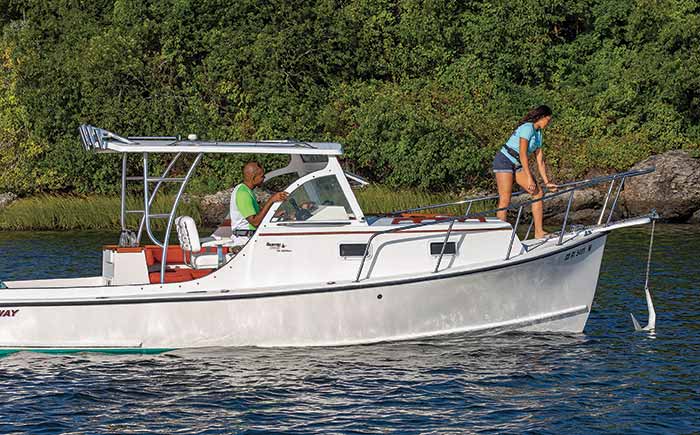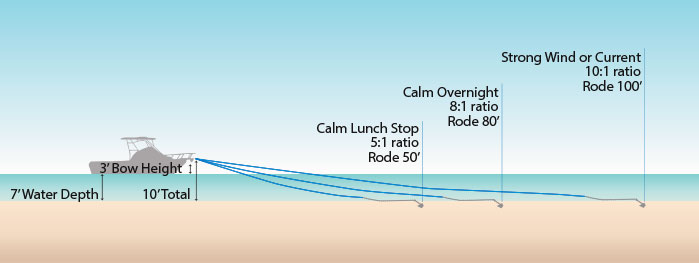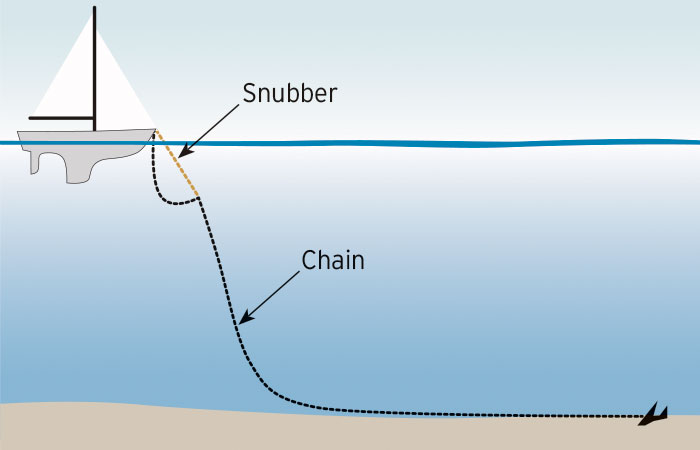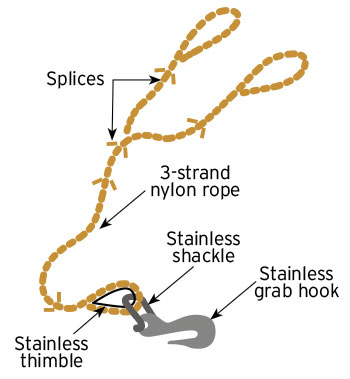Advertisement
Take your time, don't overdo the engine, and let nature do most of the work.

In advance, work out silent communications between the spotter at the bow, and the helmsperson: When the spotter wants slow RPM, she raises one finger. More RPM, hand in circular motion. Neutral, hand up. Less RPM, hand palm down. Kill engine, fist. Develop your own hand signals, review them with crew, and stick to them. (Photo: Billy Black)
Now, let's go through the steps for how to drop the hook and make sure your anchor holds.
Prepare For Anchoring
Before the anchor goes over the bow, make sure you have plenty of rode and that it's free of tangles and ready to run. Anchor rode that you've already marked with the length helps you determine how much to put out. A length of chain helps weigh the rode down at the anchor, ensuring better holding. When you're ready to set, the boat should be motionless, or drifting very slowly astern. Any forward motion may knock the anchor against the boat's stem. This is especially true on boats with a plumb (vertical) bow. Forward motion can also cause the boat to run over the rode, possibly setting the anchor in the wrong direction and also fouling keel, rudder, and prop.
Penny Rode Markers
Measure your anchor rode, then, in some easy-to-remember pattern, attach zip ties through a chain link or to one strand of three-strand line. My system is one tie at 25 feet, two at 50 feet, three at 75 feet, and four at 100 feet. Then I just repeat the pattern, one tie at 125 feet, and so on. Some other progression might work better for you. The only takeaway here is that you must mark your rode in some manner, and zip ties do the job perfectly for just a penny each.
— Don Casey
Drop The Hook
Pick a spot to drop anchor, keeping in mind where you want the boat to end up and that the anchor will drag a short distance before it sets. As the boat drifts back, lower the anchor to the bottom, then gently pay out the rode. This will prevent the chain from piling up in a heap. If the anchor and rode all pay out in one line, free of tangles, everything should be ready to set it securely in the bottom. Take a turn around a cleat, if using a rode, and snub it off every now and then to take the pressure off your windlass and to let the tackle straighten out on the bottom.
Which One Is Best?
Results Of A Head-To-Head Anchor Test
Several years ago, Fortress Marine Anchors sponsored an in-water test of 11 different anchors to determine the holding power of each in a typical soft mud bottom. The test vessel was a position-stabilized research vessel from the University of Maryland Center for Environmental Science. Here are test takeaways:
- The anchors that set the quickest and hardest were usually the ones with the sharpest flukes.
- Few anchors exceeded 700 pounds of holding power, the American Boat and Yacht Council's calculated load in high winds for a 30-foot boat; 5 of the 11 anchors only reached 700 pounds once.
- The Danforth and Fortress with their long, wide flukes outperformed the claw and plow anchors in holding power in soft mud.
- "New generation" anchors performed no better than older designs.
- Mantus and ULTRA were the only new-gen anchors that exceeded 700 pounds of tension on three of five sets.
- The Fortress FX-37 at the 45-degree fluke angle was the overall holding power winner with three sets holding over 1,000 pounds and two sets exceeding 2,000 pounds.
- Like real life, most anchors had one good set that far exceeded the rest. Almost all had one trial where the anchor didn't seem to engage the bottom at all, reinforcing the need to take your time when anchoring, letting the anchor settle before backing down on it.
- It took between 10 and 20 feet of dragging for most anchors to reach 300 pounds of holding power, a bare minimum to consider for an anchor of this size.
— Charles Fort
Pay Out Proper Scope
Your anchor holds best when the load on it is horizontal, not vertical. So let out enough scope to accomplish that. First, add the depth of the water to the height of the bow from the water, then multiply that by 5 and pay out that amount of rode for a "lunch hook" when you'll be aboard, awake, and watching in calm conditions. If the tide is coming in, adjust for it so you rest at 5-to-1 scope once it's fully in. If it's windy or you might go ashore for a bit, pay out at least a 7-to-1 scope. If you're spending the night on the hook, pay out an 8-to-1 scope. NOTE: When you calculate scope, don't include the chain at the anchor end of the rode unless there's more than 6 feet or so; the chain's job is simply to weigh down the anchor.

Depending on the wind strength and length of time at anchor here are appropriate scope recommendations for a mixed rope/chain rode. For larger boats or for anchoring overnight, two to four boat lengths of chain attached to your rode is ideal.
So, for example, if you're anchoring in water that's 10 feet deep and your bow is 5 feet above the waterline, water depth (10) + bow height (5) = 15 feet, which means that for a lunch hook you should put out 75 feet of rode (15 feet x 5).
Tip
For an overnight stop in the same location, put out 120 feet (15 feet x 8), and so on. Some circumstances such as bottom type or expectation of a storm may call for more rode. But always make sure to stay clear of any boat or obstruction down wind or current.
Chain Rode Vs. Line
Chain is far more durable if you happen to anchor in bits of coral, rock, or debris. Also, chain will dig into mud or soft sand, helping the anchor. It forms a catenary, or curve, in the rode helping to keep the pull on the anchor horizontal so it digs in when under tension. An all-chain rode has some catenary in all but the strongest (i.e., hurricane) winds.

Photo: Getty Images/gvm61
Catenary comes from weight, but unfortunately, weight is often the last thing you want aboard, and too much of it in the bow can adversely affect a boat's handling. Unless you have a larger boat, or you're going cruising, an optimal rode is composed of a length of relatively heavy chafe-resistant chain attached to the anchor, then a lightweight, strong, stretchy line attached to the chain — the best of both worlds.
Nylon line gets its shock-absorbing properties from stretch rather than through catenary action, and it's this property, along with its lighter weight and strength, that makes it a good rode. Three-strand nylon line has the most stretch. Polyester line is about 15% stronger and more resistant to chafe but doesn't absorb shock as well. Avoid using polypropylene line for this reason.
One to two boat lengths of chain is sufficient for most purposes, although more is always better. Be aware that with a rope/chain rode, only certain windlasses can bring in rope and chain on the same gypsy. Those that can will require that you use a rope-to-chain splice, which can be more vulnerable to chafe when not maintained/checked seasonally.
To create an effective rode, use good quality shackles to tie the system together, and mouse the pin to prevent it from unscrewing at a bad time.
— Bob Adriance
Set The Hook
Once you've let out ample scope, let the boat settle back on the anchor to straighten out the rode. A gentle breeze or a mild current may be sufficient for this step. If not, use the engine with just a touch of reverse. Pause and take a good look around, especially abeam (opposite the boat's middle), and note your position relative to other fixed objects.
Now, put the engine in SLOW reverse. You can expect to move slightly astern as the anchor and rode set themselves and stretch out. Soon, though, the boat should settle in a fixed position. If at this stage the boat is still moving astern, your anchor may be dragging; pick it up and dragging; pick it up and drop it again, perhaps in a different spot. If the boat's position is fixed, you should see prop wash alongside aft, and your anchor rode should be straight and taut.
To thoroughly set the anchor, with the engine still in reverse, increase the rpm. If the boat stays put, you can rest (relatively) easy, knowing you're hooked. Check your swinging room again, assuming that the wind or current might come from any direction.
How To Rig A Snubber
An anchor snubber, or snubbing line, performs two important functions for boats using all-chain rode: absorbing shock loads to an anchor rode and preventing the anchor windlass from taking all the strain as the boat swings at anchor and rises and falls with waves.

Notice how all the strain is taken by the snubbing line. The anchor chain is slack between where the snubber attaches and the windlass.

The simplest way to rig a snubber is, after setting the hook, attach a 20-foot length of nylon line (ideal because it stretches) to the chain or rode using a rolling hitch, before you deploy the final length of chain. (Lengths may vary depending on your circumstances.) Attach the other end of the subbing line to a strong bow cleat, then feed out more anchor chain/rode until it hangs loosely between the rolling hitch and the windlass or other point where it attaches to the boat.
When rigged correctly, all the weight is taken by the snubbing line, not the windlass. Also, letting your chain loop down between the rolling hitch and cleat will add additional weight, thus producing more catenary effect which may improve the holding power of the anchor and give additional shock absorption to the rode.
To make rigging a snubber even quicker, many boaters with all-chain rode invest in a snubbing hook or chain hook. Both come in different sizes to suit the size of your chain and can be permanently spliced into the end of a suitable snubbing line. Once you're successfully anchored, slip the specially shaped hook over a chain link, attach the other end of the snubber to the boat, then let out a bit more chain until the snubber is taut.
— Mark Corke
